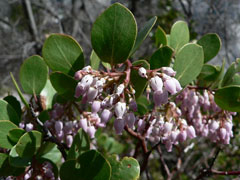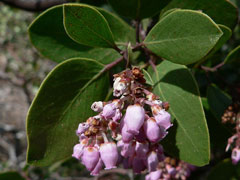 |
|
http://commons.wikimedia.org/wiki/User:Wsiegmund |
 |
| http://commons.wikimedia.org/wiki/User:Wsiegmund |
Translate this page:
Summary
Greenleaf manzanita produces abundant fruits, but their high astringency makes them less palatable than other manzanitas. Edible in moderation, more valuable historically than as a modern wild food.
Physical Characteristics

 Arctostaphylos patula is an evergreen Shrub growing to 2 m (6ft) by 2 m (6ft).
Arctostaphylos patula is an evergreen Shrub growing to 2 m (6ft) by 2 m (6ft).
See above for USDA hardiness. It is hardy to UK zone 6. It is in leaf all year, in flower from March to May, and the seeds ripen from August to October. The species is hermaphrodite (has both male and female organs) and is pollinated by Bees. The plant is self-fertile.
Suitable for: light (sandy) and medium (loamy) soils and prefers well-drained soil. Suitable pH: mildly acid soils and can grow in very acid soils.
It can grow in semi-shade (light woodland) or no shade. It prefers moist soil.
UK Hardiness Map
US Hardiness Map
Synonyms
Plant Habitats
Woodland Garden Sunny Edge; Dappled Shade;
Edible Uses
Edible Parts: Fruit Seed
Edible Uses:
Fruits are edible but often disappointing. They are usually reddish-brown drupes with thin, sweet but astringent pulp around very hard nutlets (4–8 per fruit). The fruits can be eaten fresh, dried, or ground into meal, but overly astringent ones are best avoided. Unripe fruits resemble small apples and are tart or bland. Flowers are edible but bitter-sweet and better steeped into tea than eaten raw [2-3]. Fruits can be dried and ground into flour for porridges or drinks. They were used by Native peoples in fermented cider-like beverages.Fruit - raw or cooked[3, 94, 105, 161]. The fully ripe fruit is pleasantly acid with a flavour resembling green apples[183]. It can be dried, ground into a powder then used in making cakes etc[257]. The fruit can also be used for making jelly and cider[183]. The fruit is about 8 - 10mm in diameter[200]. Seed - ground into a powder and added to soups etc[92]. The seed is very small and would be difficult to separate from the fruit. It would be easier to dry the whole fruit, grind this into a powder and use it in soups etc[K].
References More on Edible Uses
Medicinal Uses
Plants For A Future can not take any responsibility for any adverse effects from the use of plants. Always seek advice from a professional before using a plant medicinally.
Astringent Poultice VD
The leaves are astringent[94]. They have been used in the treatment of VD[257]. They are also used as a poultice on burns, cuts etc[257].
References More on Medicinal Uses
The Bookshop: Edible Plant Books
Our Latest books on Perennial Plants For Food Forests and Permaculture Gardens in paperback or digital formats.

Edible Tropical Plants
Food Forest Plants for Hotter Conditions: 250+ Plants For Tropical Food Forests & Permaculture Gardens.
More

Edible Temperate Plants
Plants for Your Food Forest: 500 Plants for Temperate Food Forests & Permaculture Gardens.
More

More Books
PFAF have eight books available in paperback and digital formats. Browse the shop for more information.
Shop Now
Other Uses
Dye
A yellowish-brown dye is obtained from the leaves, it does not require a mordant[168].
Special Uses
References More on Other Uses
Cultivation details
Habitat & Growing Conditions: Found in mountain woodlands with oak, pine, aspen, and spruce communities across the western U.S. Prefers dry, rocky soils and full sun to light shade. Blooms from March to July, fruits mature June–October. Requires a deep moist well-drained light or medium lime-free loam in sun or semi-shade[3, 11, 166, 200] but plants produce less fruit when they are grown in the shade[200]. Prefers a soil that is dry in the summer[184]. Plants are not very wind-firm[11]. Plants are hardy to about -10°c[184]. This species was growing well at Chelsea Physic garden after the harsh winter of 1985/86, showing no signs of damage[11]. Highly fire resistant[155], it can regenerate after a forest fire from a mallee-like base[166, 184]. Plants self-layer in nature[155]. A very ornamental plant[1], it grows well in Britain[3]. Plants resent root disturbance and should be placed in their final positions as soon as possible[11, 134]. Growth & Ecology:
Evergreen shrub, 0.5–2.5 m tall, with sticky hairs on twigs and smooth reddish bark. Populations are reliable fruit bearers even in drought years.
References Carbon Farming Information and Carbon Sequestration Information
Temperature Converter
Type a value in the Celsius field to convert the value to Fahrenheit:
Fahrenheit:
The PFAF Bookshop
Plants For A Future have a number of books available in paperback and digital form. Book titles include Edible Plants, Edible Perennials, Edible Trees,Edible Shrubs, Woodland Gardening, and Temperate Food Forest Plants. Our new book is Food Forest Plants For Hotter Conditions (Tropical and Sub-Tropical).
Shop Now
Plant Propagation
Seed - best sown in a greenhouse as soon as it is ripe. Pre-soak dried seed in boiling water for 10 - 20 seconds or burn some straw on top of them and then stratify at 2 - 5°c for 2 months[11, 200]. The seed usually germinates in 2 - 3 months at 15°c[134]. When large enough to handle, prick the seedlings out into individual pots and grow them on in a cold frame or greenhouse for at least their first winter. Plant out in late spring or early summer. Cuttings of side shoots of the current season's growth, 5 - 8cm with a heel, August to December in a frame. The cuttings are very slow and can take a year to root[1, 78]. This species is very difficult from cuttings[166]. Division in early spring. Take care because the plant resents root disturbance. Pot the divisions up and keep them in a lightly shaded position in a cold frame or greenhouse until they are growing away actively. Layering in spring[200].
Other Names
If available other names are mentioned here
Greenleaf or Roundleaf Manzanita (Arctostaphylos patula Greene)
Native Range
NORTHERN AMERICA: United States (Colorado, Montana, Oregon, Washington, Arizona, California, Nevada), Mexico (Baja California (Norte))
Weed Potential
Right plant wrong place. We are currently updating this section.
Please note that a plant may be invasive in one area but may not in your area so it's worth checking.
Low; it is a native species adapted to its habitat, not invasive.
Conservation Status
IUCN Red List of Threatened Plants Status :

| Related Plants
|
| Latin Name | Common Name | Habit | Height | Hardiness | Growth | Soil | Shade | Moisture | Edible | Medicinal | Other |
| Arctostaphylos alpina | Alpine Bearberry | Shrub | 0.1 |
-
| | LM | SN | M | 2 | 1 | |
| Arctostaphylos columbiana | Hairy Manzanita | Shrub | 1.5 |
6-9
| | LM | SN | M | 2 | 1 | 2 |
| Arctostaphylos glauca | Bigberry Manzanita | Shrub | 4.0 |
7-10
| | LM | SN | DM | 2 | 2 | 3 |
| Arctostaphylos manzanita | Manzanita, Whiteleaf manzanita, Konocti manzanita, Contra Costa manzanita, Roof's manzanita, Wieslan | Shrub | 2.0 |
7-10
| M | LM | SN | DM | 3 | 1 | 3 |
| Arctostaphylos nevadensis | Pine-Mat Manzanita | Shrub | 0.1 |
5-9
| M | LM | SN | M | 2 | 1 | 3 |
| Arctostaphylos parryana | Parry Manzanita | Shrub | 1.8 |
-
| | LM | SN | DM | 1 | 0 | 1 |
| Arctostaphylos pringlei | Stickleaf Manzanita | Shrub | 2.0 |
7-9
| M | LM | N | DM | 3 | 0 | 1 |
| Arctostaphylos pungens | Grayleaf manzanita, Pointleaf Manzanita | Shrub | 2.0 |
7-10
| | LM | SN | DM | 3 | 1 | 2 |
| Arctostaphylos stanfordiana | Stanford's manzanita, Rincon manzanita | Shrub | 1.5 |
5-9
| | LM | SN | DM | 3 | 0 | 1 |
| Arctostaphylos tomentosa | Downy Manzanita, Woollyleaf manzanita, Brittleleaf manzanita, Dacite manzanita, Rosy manzanita, San | Shrub | 1.5 |
7-10
| | LM | SN | M | 3 | 3 | 3 |
| Arctostaphylos uva-ursi | Bearberry, Kinnikinnick | Shrub | 0.1 |
2-8
| M | LM | FSN | M | 3 | 4 | 4 |
| Vaccinium arctostaphylos | Caucasian Whortleberry | Shrub | 3.0 |
5-9
| | LM | SN | M | 3 | 0 | 0 |
|
Growth: S = slow M = medium F = fast. Soil: L = light (sandy) M = medium H = heavy (clay). pH: A = acid N = neutral B = basic (alkaline). Shade: F = full shade S = semi-shade N = no shade. Moisture: D = dry M = Moist We = wet Wa = water.
Now available:
Food Forest Plants for Mediterranean Conditions
350+ Perennial Plants For Mediterranean and Drier Food Forests and Permaculture Gardens.
[Paperback and eBook]
This is the third in Plants For A Future's series of plant guides for food forests tailored to
specific climate zones. Following volumes on temperate and tropical ecosystems, this book focuses
on species suited to Mediterranean conditions—regions with hot, dry summers and cool, wet winters,
often facing the added challenge of climate change.
Read More
Expert comment
Author
Greene.
Botanical References
1160200
Links / References
For a list of references used on this page please go here
Readers comment
© 2010, Plants For A Future. Plants For A Future is a charitable company limited by guarantee, registered in England and Wales. Charity No. 1057719, Company No. 3204567.